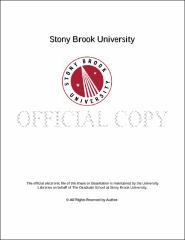| dc.identifier.uri | http://hdl.handle.net/11401/76711 | |
| dc.description.sponsorship | This work is sponsored by the Stony Brook University Graduate School in compliance with the requirements for completion of degree. | en_US |
| dc.format | Monograph | |
| dc.format.medium | Electronic Resource | en_US |
| dc.language.iso | en_US | |
| dc.publisher | The Graduate School, Stony Brook University: Stony Brook, NY. | |
| dc.type | Dissertation | |
| dcterms.abstract | The spatial periodicity of the crystal structure dictates the electronic band structure theory as the fundamental paradigm in solid state physics. The original translation in materials is commonly broken with an enlarged unit cell required by spontaneously developed long-range order or multiple competing periodicities. The former happens in the systems undergoing the phase transition to antiferromagnetism, charge/spin density waves or lattice distortion. The latter originates from the intrinsic arrangement of the multiple atom system or the externally introduced impurities. The emergence of the broken symmetry can significantly modify the electronic structure, shift the chemical potential, and change the electric, magnetic or optical response in the experimental measurement. In this thesis, the impact of the translational symmetry breaking on various materials is investigated by utilizing the first-principles Wannier functions. We represent the electronic structure by calculating the one-particle spectral function in the reference momentum basis corresponding to a shorter periodicity. In the first case, the lattice distortion in Li metal at high pressures is found to cause the Fermi surface topological change, termed Lifshitz transition. This transition triggers an anomalous enhancement of superconductivity. In the second case, we formulate a theoretical approach to create massless Dirac particles in one-band two-dimensional lattice from the inspiration of understanding Dirac cone formation in graphene. In the last case, we discuss that staggered tetrahedral structures in Fe-based superconductors can imply the orbital-parity selective physics in the quasi-particles and superconducting pairing structures. | |
| dcterms.available | 2017-09-20T16:51:02Z | |
| dcterms.contributor | Allen, Philip | en_US |
| dcterms.contributor | Ku, Wei | en_US |
| dcterms.contributor | Schneble, Dominik | en_US |
| dcterms.contributor | Hybertsen, Mark. | en_US |
| dcterms.creator | Lin, Chia-Hui | |
| dcterms.dateAccepted | 2017-09-20T16:51:02Z | |
| dcterms.dateSubmitted | 2017-09-20T16:51:02Z | |
| dcterms.description | Department of Physics. | en_US |
| dcterms.extent | 120 pg. | en_US |
| dcterms.format | Application/PDF | en_US |
| dcterms.format | Monograph | |
| dcterms.identifier | http://hdl.handle.net/11401/76711 | |
| dcterms.issued | 2013-12-01 | |
| dcterms.language | en_US | |
| dcterms.provenance | Made available in DSpace on 2017-09-20T16:51:02Z (GMT). No. of bitstreams: 1
Lin_grad.sunysb_0771E_11662.pdf: 14230161 bytes, checksum: 85eb1ae9c216d110be485efdf754411a (MD5)
Previous issue date: 1 | en |
| dcterms.publisher | The Graduate School, Stony Brook University: Stony Brook, NY. | |
| dcterms.subject | Physics | |
| dcterms.subject | band structure, Fe-based superconductor, graphene, superconductivity | |
| dcterms.title | Translational Symmetry Breaking in Materials: First-principles Wannier Function Study | |
| dcterms.type | Dissertation | |

